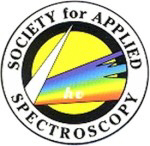
Society for Applied Spectroscopy
Encyclopedia

Research
Research can be defined as the scientific search for knowledge, or as any systematic investigation, to establish novel facts, solve new or existing problems, prove new ideas, or develop new theories, usually using a scientific method...
and education
Education
Education in its broadest, general sense is the means through which the aims and habits of a group of people lives on from one generation to the next. Generally, it occurs through any experience that has a formative effect on the way one thinks, feels, or acts...
in the fields of spectroscopy
Spectroscopy
Spectroscopy is the study of the interaction between matter and radiated energy. Historically, spectroscopy originated through the study of visible light dispersed according to its wavelength, e.g., by a prism. Later the concept was expanded greatly to comprise any interaction with radiative...
, optics
Optics
Optics is the branch of physics which involves the behavior and properties of light, including its interactions with matter and the construction of instruments that use or detect it. Optics usually describes the behavior of visible, ultraviolet, and infrared light...
, and analytical chemistry
Analytical chemistry
Analytical chemistry is the study of the separation, identification, and quantification of the chemical components of natural and artificial materials. Qualitative analysis gives an indication of the identity of the chemical species in the sample and quantitative analysis determines the amount of...
. Founded in 1958, it is currently headquartered in Frederick, MD. In 2006 it had about 2,000 members worldwide.
SAS is perhaps best known for its technical conference with the Federation of Analytical Chemistry and Spectroscopy Societies and short courses on various aspects of spectroscopy and data analysis. The society publishes the scientific journal Applied Spectroscopy.
SAS is affiliated with American Institute of Physics (AIP), Coblentz, Council for Near Infrared Spectroscopy (CNIRS), Federation of Analytical Chemistry and Spectroscopy Societies (FACSS), The Instrumentation, Systems, and Automation Society (ISA), and Optical Society of America (OSA)
See also
SpectroscopySpectroscopy
Spectroscopy is the study of the interaction between matter and radiated energy. Historically, spectroscopy originated through the study of visible light dispersed according to its wavelength, e.g., by a prism. Later the concept was expanded greatly to comprise any interaction with radiative...
American Institute of Physics (AIP)
American Institute of Physics
The American Institute of Physics promotes science, the profession of physics, publishes physics journals, and produces publications for scientific and engineering societies. The AIP is made up of various member societies...
The Instrumentation, Systems, and Automation Society (ISA)
Instrumentation, Systems, and Automation Society
The International Society of Automation , formerly known as The Instrumentation, Systems, and Automation Society, is a non-profit technical society for engineers, technicians, businesspeople, educators and students, who work, study or are interested in industrial automation and pursuits related to...
Optical Society of America (OSA)
Optical Society of America
The Optical Society is a scientific society dedicated to advancing the study of light—optics and photonics—in theory and application, by means of publishing, organizing conferences and exhibitions, partnership with industry, and education. The organization has members in more than 100 countries...

